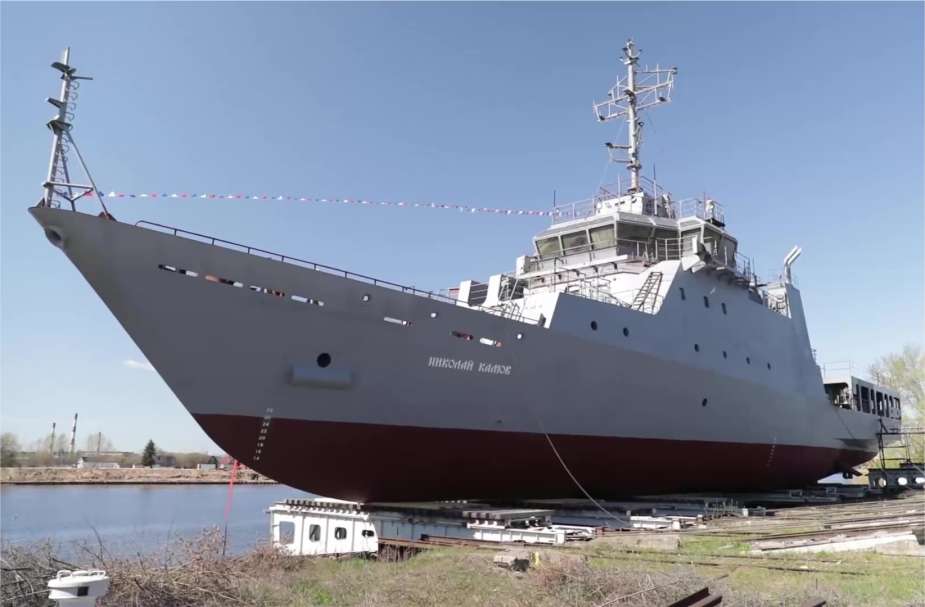Breaking news
Russian Navy launches Nikolai Kamov as sole Project 14400 vessel for helicopter pilot training.
On April 26, 2024, the "Nikolai Kamov," the first and only vessel of Project 14400 designed for training naval helicopter pilots, was launched by the Ship Repair and Shipbuilding Corporation at their facility in Gorodets, Nizhny Novgorod region. This ship, named after aircraft designer Nikolai Ilyich Kamov, was laid down on June 28, 2018, and left the boathouse on October 18, 2021.
Follow Navy Recognition on Google News at this link
 On April 26, 2024, the "Nikolai Kamov," the first and only vessel of Project 14400 designed for training naval helicopter pilots, was launched by the Ship Repair and Shipbuilding Corporation. (Picture source: Russian MoD)
On April 26, 2024, the "Nikolai Kamov," the first and only vessel of Project 14400 designed for training naval helicopter pilots, was launched by the Ship Repair and Shipbuilding Corporation. (Picture source: Russian MoD)
The ship was designed by the Naval Architecture and Marine Engineering Center Baltsudoproekt and ordered by the Krylov State Research Centre (KSRC) for the Russian Navy, and the Ship Repair and Shipbuilding Corporation, established in 2001 from the Gorodets Shipbuilding Yard, played a crucial role in the vessel's construction. The launch ceremony was attended by several high-ranking officials, including Dmitry Savin, General Director of PJSC Ship Repair and Shipbuilding Corporation; Rear Admiral Ilyas Shigapov, Head of the Shipbuilding Department of the Main Command of the Navy; and Colonel Andrey Pakhomov, Chief of Naval Aviation of the Navy, along with other military and local government dignitaries.
This special marine vessel, named after the renowned aircraft designer Nikolai Ilyich Kamov, is the lead vessel of its project and there are no immediate plans to continue this series of training ships, making it a unique addition to the Russian naval assets. Following completion of its construction and sea trials, the "Nikolai Kamov" is set to be transferred to the 859th Center for Combat Use and Retraining of Naval Aviation Flight Personnel based in Yeisk. This center plays a pivotal role in the ongoing professional development of the Russian Navy's aviation personnel, enhancing their combat and operational capabilities.

With a total displacement of less than 900 tons, the ship measures 66.9 meters in length, 12.7 meters in width, and has a draft of 2.1 meters. (Picture source: Russian MoD)
With a total displacement of less than 900 tons, the ship measures 66.9 meters in length, 12.7 meters in width, and has a draft of 2.1 meters. It can reach a top speed of 12 knots, has a cruising range of 500 miles, and maintains autonomy for two days. The ship includes specialized equipment that simulates various deck landing scenarios for training purposes, catering specifically to the operation of Ka-27/29/31 and Ka-52 helicopters, as well as testing new types of ship-based helicopters. This training is deemed crucial for preparing pilots for the complex demands of naval operations.
The vessel is designed for takeoff and landing drills under various conditions, including different weather scenarios, day or night, and with ship movements such as rolling up to 10 degrees. The training curriculum includes advanced maritime techniques, such as countering sea-based drone threats, reflecting specific operational requirements.
The push to initiate and execute this project, also nicknamed the 'floating deck', aligns with the experiences and operational challenges encountered by Russian forces during the conflict in Ukraine, which underscored the need for specialized training in naval aviation. The lessons learned have necessitated a focus on pilots' proficiency with various aviation and technical equipment, electronic aviation control systems, and other specialized gear used on warships.
In addition to its primary training function, the vessel will also conduct patrol missions across different maritime regions, integrating operational patrols with training activities. The creation of helicopter detachments to counter surface drones, as previously reported by Russian media, aligns with broader military strategic adjustments. These units, equipped with helicopters such as the Ka-27, Ka-29, and Mi-8, have since begun active operations in the Black Sea region, as the developments in drone technology by Ukrainian forces, which have been effective in targeting naval assets, have prompted a Russian response to improve tactical responses and operational capabilities. This includes the development of specialized equipment that facilitates direct communication between helicopters and navy drones, allowing for the real-time transmission of operational data and enhancing the targeting and navigational capabilities of helicopter crews.

The ship includes specialized equipment that simulates various deck landing scenarios for training purposes, catering specifically to the operation of Ka-27/29/31 and Ka-52 helicopters, as well as testing new types of ship-based helicopters. (Picture source: Russian MoD)


























